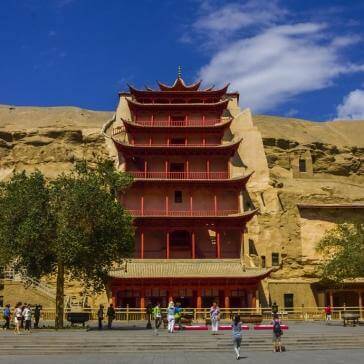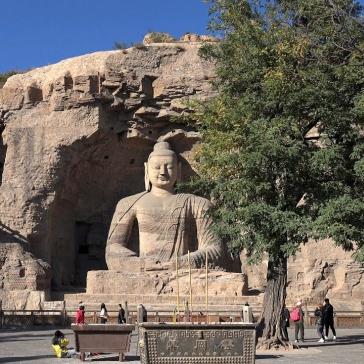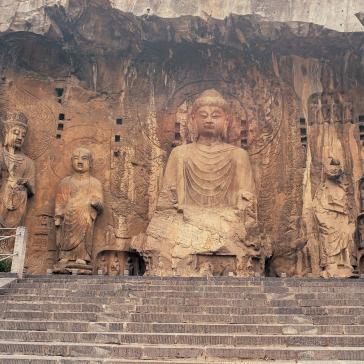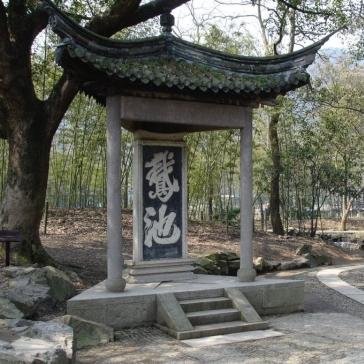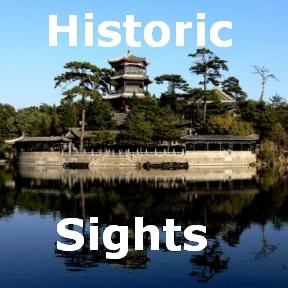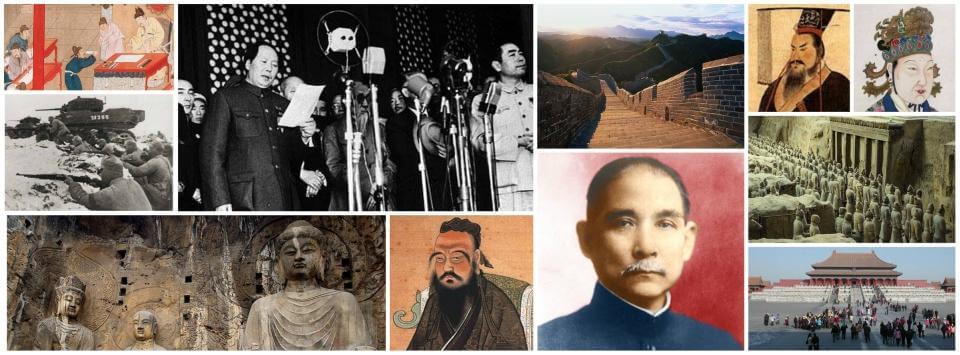
The Six Dynasties (AD 220 – 589)
The Three Kingdoms (AD 220 – 280)
The Han dynasty was brought to an end in AD 220, when the warlord Cao Pi forced the Han emperor Xian to abdicate and afterwards founded the state of Wei with himself as emperor. The following two years saw the founding of the state of Wu and the state of Shu Han (also referred to as kingdoms, even though its leaders ruled as emperors). These three states or kingdoms competed for supremacy in the ensuing years. That's why the period from AD 220 - 280 is now referred to as the period of the Three Kingdoms.
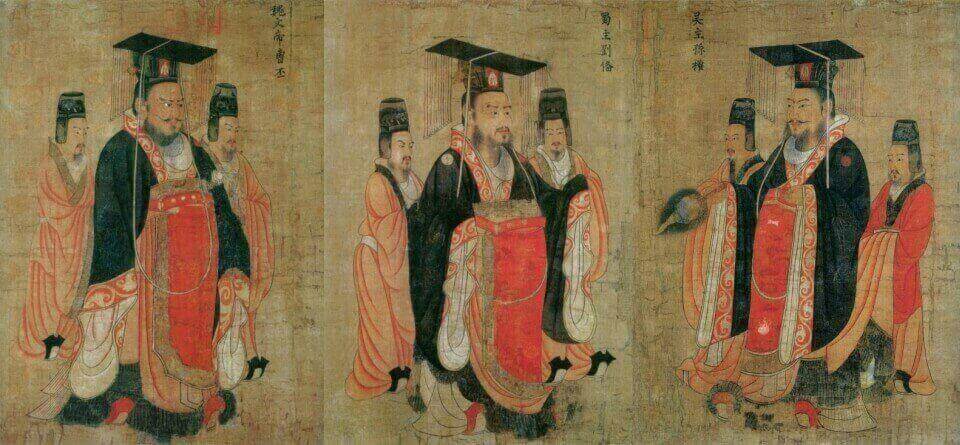 Left: Cao Pi, the Emperor of Wei Middle: Liu Bei, the Emperor of Shu Han Right: Sun Quan, the Emperor of Wu (Tang dynasty paintings by Yan Liben)
Left: Cao Pi, the Emperor of Wei Middle: Liu Bei, the Emperor of Shu Han Right: Sun Quan, the Emperor of Wu (Tang dynasty paintings by Yan Liben)
However, Liu Bei (AD 162 - 223) - the self-proclaimed emperor of Shu Han in the southwest of China (nowadays Sichuan province) - saw his state as a continuation of the Han dynasty, since he descended from the same Liu family that had ruled this dynasty.
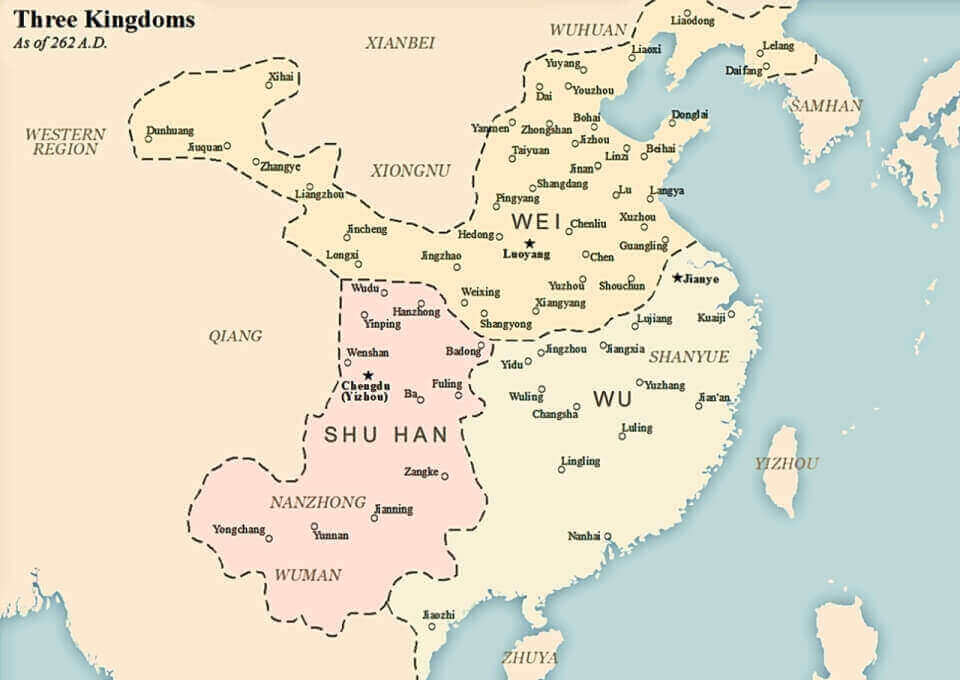 Map of the Three Kingdoms Wei, Wu and Shu Han
Map of the Three Kingdoms Wei, Wu and Shu Han
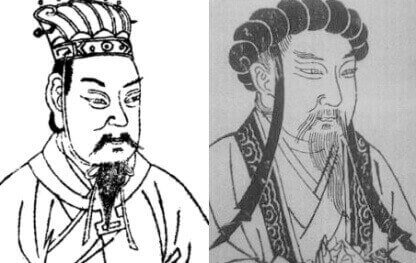 Left: the warlord Cao Cao, father of Cao Pi Right: General Zhuge LiangIn China's north, Cao Pi (reign: AD 220 - 226) ruled as the emperor of the Wei state. His father Cao Cao (AD 155 - 220), the adopted son of a eunuch, had won the territory in the north of China through military means. The third ruler in the southeast of China was Sun Quan (AD 182 - 252), who ruled the state of Wu.
Left: the warlord Cao Cao, father of Cao Pi Right: General Zhuge LiangIn China's north, Cao Pi (reign: AD 220 - 226) ruled as the emperor of the Wei state. His father Cao Cao (AD 155 - 220), the adopted son of a eunuch, had won the territory in the north of China through military means. The third ruler in the southeast of China was Sun Quan (AD 182 - 252), who ruled the state of Wu.
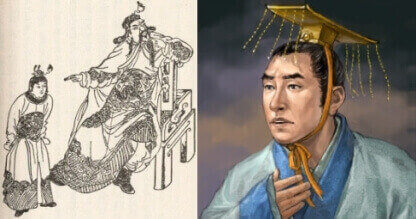 Left: Portrait of the statesman Sima Zhao (seated) from a Qing Dynasty edition of The Romance of the Three Kingdoms Right: Cao Huan, the last emperor of the state of WeiIt was a period dominated by cunning military leaders (instead of emperors, philosophers or scholars), who often tried to outwit their enemies instead of using blunt military force. Cao Cao - whose military exploits took place just before the fall of the Han dynasty - and the general Zhuge Liang (AD 181 - 234) are nowadays considered to have been the best military strategists of this period.
Left: Portrait of the statesman Sima Zhao (seated) from a Qing Dynasty edition of The Romance of the Three Kingdoms Right: Cao Huan, the last emperor of the state of WeiIt was a period dominated by cunning military leaders (instead of emperors, philosophers or scholars), who often tried to outwit their enemies instead of using blunt military force. Cao Cao - whose military exploits took place just before the fall of the Han dynasty - and the general Zhuge Liang (AD 181 - 234) are nowadays considered to have been the best military strategists of this period.
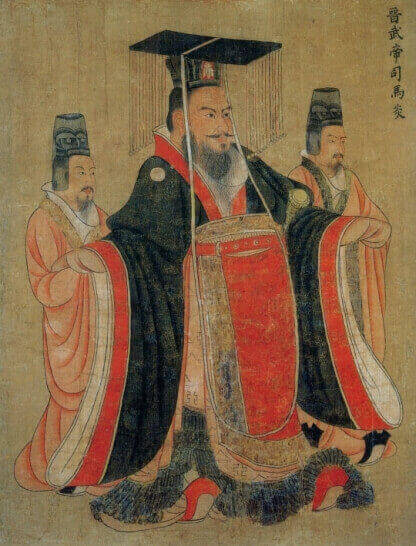 Sima Yan, the Emperor Wu of the Jin dynasty (Tang dynasty painting by Yan Liben)Many stories and poems about these military exploits and deceptions (straw boats borrow arrows, Zhuge Liang playing chess on the city wall in view of the approaching enemy army) were written down and they became the plot of plays and operas. That's why the Three Kingdom Period is nowadays seen by the Chinese as a period of great adventure and romance. Some of these adventurous and romantic stories were immortalized in the classic Chinese novel "The Romance of the Three Kingdoms".
Sima Yan, the Emperor Wu of the Jin dynasty (Tang dynasty painting by Yan Liben)Many stories and poems about these military exploits and deceptions (straw boats borrow arrows, Zhuge Liang playing chess on the city wall in view of the approaching enemy army) were written down and they became the plot of plays and operas. That's why the Three Kingdom Period is nowadays seen by the Chinese as a period of great adventure and romance. Some of these adventurous and romantic stories were immortalized in the classic Chinese novel "The Romance of the Three Kingdoms".
The prevalence of and reverence for military leaders in these three kingdoms ensured continuing warfare between them. Despite all this continuing military conflict, all three kingdoms were relatively stable politically and regarding their Confucian system of administration that relied heavily upon the established conventions of the Han dynasty.
In AD 263, the kingdom of Shu Han was incorporated through conquest into the state of Wei, that was effectively already ruled then by the regent Sima Zhao with its nominal Emperor Cao Huan as a figurehead leader.
Two years later in AD 265, Sima Yan (Sima Zhao's son) forced the abdication of the reigning puppet ruler Cao Huan.
Jin Dynasty (AD 265 – 420)
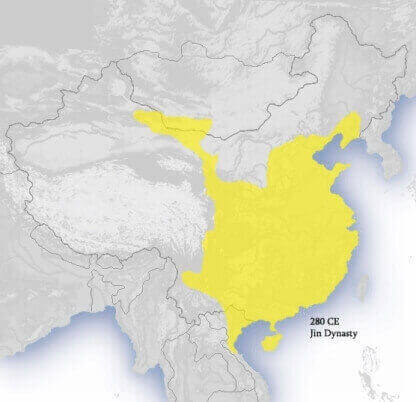 Map of the Jin dynasty state in AD 280That event marks the beginning of the Jin dynasty, which managed to briefly unify China once more in AD 280, when its last rival - the state of Wu - surrendered. Even though the Jin dynasty continued in some form until AD 420, its period of national unity and stability was very short. That was due to the instability that resulted from both the internal power struggle that followed Sima Yan's death (who had reined as Emperor Wu of the Jin dynasty) and the effects of a period of great migration of peoples from the Northwest.
Map of the Jin dynasty state in AD 280That event marks the beginning of the Jin dynasty, which managed to briefly unify China once more in AD 280, when its last rival - the state of Wu - surrendered. Even though the Jin dynasty continued in some form until AD 420, its period of national unity and stability was very short. That was due to the instability that resulted from both the internal power struggle that followed Sima Yan's death (who had reined as Emperor Wu of the Jin dynasty) and the effects of a period of great migration of peoples from the Northwest.
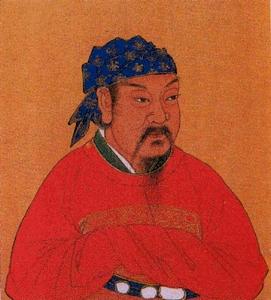 Liu Yu alias Emperor Wu, the founder of the Liu Song dynastyThe nomadic Xiongnu people (who would eventually be known as the Huns) had already during the Han dynasty been an occasional source of conflict in the northwest of China.
Liu Yu alias Emperor Wu, the founder of the Liu Song dynastyThe nomadic Xiongnu people (who would eventually be known as the Huns) had already during the Han dynasty been an occasional source of conflict in the northwest of China.
During periods of a weak empire, they had launched raids into Han controlled territory, whereas they were content with trading goods when the Han empire was stronger. The Xiongnu people were part of an alliance of 'barbaric' people from the northwest who shattered the unity and stability of the Jin dynasty which culminated in the fall of the Jin capital Luoyang in AD 311 and of its secondary capital Chang'an in AD 316.
After these crushing defeats, the remaining Jin loyalists (henceforth known as the Eastern Jin) tried to regroup and regain their strength after their retreat to the south of China. Their military expeditions that were meant to regain the lost territory in the north mostly failed at first and the Jin had to contend with a resurging Qin state in the north.
Despite its name, this state of "Former Qin" was much less powerful than the Qin Dynasty state that had unified and ruled China several centuries earlier. It did however achieve the complete unification of North China in AD 376 and it was also during its short-lived reign of that part of China that the very first caves of the now world-famous Mogao Caves were cut into the side of a cliff at an oasis along the Silk Road in the Northwestern Regions.
Later on, the Eastern Jin's military campaigns to regain territory in the north became more and more successful under the leadership of their able General Liu Yu. Liu Yu's success on the battlefield eventually allowed him to usurp the throne for himself in AD 420.
Mogao Caves
The Mogao Caves are widely considered to be the world's most famous Buddhist cave complex. Comprised of 735 cave temples that still exist today, this UNESCO World Heritage site is located about 25km southeast of Dunhuang in China's northwestern Gansu province. Construction of the caves that are sometimes also referred to as the Mogao Grottoes began in AD 366 during the period of the Six Dynasties and continued for about 1000 years.
Click here to learn more!Opening Hours
May - October: 8am - 6pm
November - April: 9am - 5.30pm
Entrance Ticket Prices
April - November: 258 yuan*
December - March: 160 yuan*
* includes Digital Exhibition Center, shuttle bus, museums and guided cave tour
Southern and Northern Dynasties (AD 420 – 589)
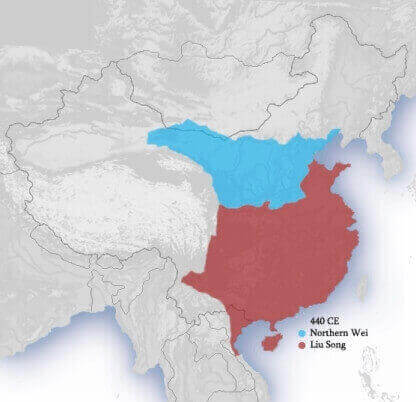 Map of the Southern and Northern Dynasties in AD 440That usurpation ended the Jin dynasty and started the Liu Song Dynasty (AD 420 - 479), the first of four short-lived dynasties that controlled the unified southern part of China in succession.
Map of the Southern and Northern Dynasties in AD 440That usurpation ended the Jin dynasty and started the Liu Song Dynasty (AD 420 - 479), the first of four short-lived dynasties that controlled the unified southern part of China in succession.
The Xiongnu people and other affiliated tribes had begun to exert pressure on the Jin state during the early 4th century, because they had been displaced from their own native areas by successive migratory waves of Central Asian people (speaking a language related to old Turkic). After displacing the Xiongnu people, these militant proto-Turkish tribes moved further towards the agricultural heartland in the northern plains of China and established themselves as military overlords of this area and its still predominantly Chinese population.
The historically most significant of these different Turkic tribes - a tribe known as the Tuoba Turks - founded the Tuoba Wei dynasty (AD 386 - 534) in the north of China. It is also known as the Northern Wei dynasty. By AD 439, the Northern Wei dynasty had reunified the northern part of China as well, just like Liu Yu's military exploits in the south had reunified the south of China. The Northern Wei's initial capital had been established in Datong (in northern Shanxi province), but its capital was later moved further south to the old imperial capital of Luoyang.
The Tuoba Turks had already been Buddhists for much longer than Buddhism had existed in China. They saw their faith as much more central to their lives than the Chinese. To show their devotion and earn merit for the afterlife, they built two great Buddhist cave temples near Datong and Luoyang. The Longmen Grottoes (Longmen = Dragon Gate) near Luoyang and the Yungang Grottoes (Yungang = Cloud Harbour) near Datong that both began to be built during the time of the Tuoba Wei dynasty now count among the major tourist attractions in the country.
Yungang Grottoes
The Yungang Grottoes are located about 16km west of Datong (Shanxi province) at the northern side of Wuzhou Mountain. This Buddhist cave complex that is sometimes also referred to as the Yungang Caves was carved into the limestone cliffs during the Northern Wei period of the Six Dynasties in the 5th and 6th century AD. Alltogether, there are 254 caves and 1100 niches at this world heritage site that contain about 51,000 statues.
Click here to learn more!Opening Hours
April - October: 8.30am - 5.30pm
November - March: 8.30am - 5pm
Exhibition Hall: 9.30am - 4.30pm
Entrance Ticket Prices
April - October: 120 yuan
November - March: 100 yuan
Free for children under 1.2m
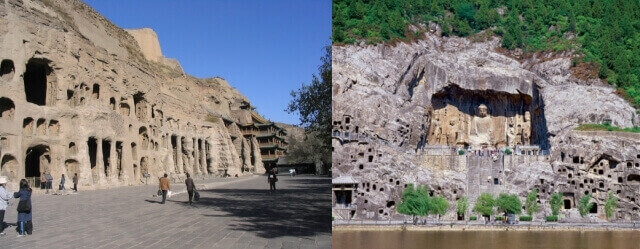 Left: View of the Yungang Grottoes near Datong Right: View of the Longmen Grottoes near Luoyang
Left: View of the Yungang Grottoes near Datong Right: View of the Longmen Grottoes near Luoyang
Longmen Grottoes
The Longmen Grottoes (a.k.a. Longmen Caves) are located about 12km south of the city of Luoyang (Henan province). About 2300 caves and niches have been carved into the limestone cliffs along a 1km stretch on both sides of the Yi River there. Even though the first Buddhist caves at this world heritage site were already built during the Northern Wei period of the Six Dynasties, most of the caves and niches were built much later.
Click here to learn more!Opening Hours
April 1st - October 7th: 8am - 6.30pm*
October 8th - October 31st: 8am - 6pm
November - January: 8am - 5pm
February - March: 8am - 6pm
* 7.30am - 7pm during national May and October holidays and Friday - Sunday of Luoyang Peony Cultural Festival
Entrance Ticket Prices
90 yuan
includes grottoes on eastern & western side of the river, Xiangshan Temple, Bai Garden
Tickets sold until 1 hour before closing time
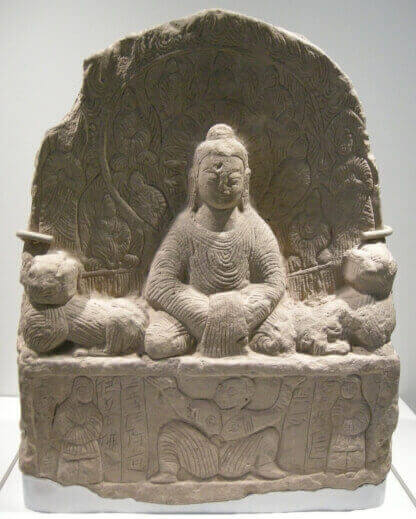 5th century Buddhist steleThe Turkic overlords, who came to China from arid lands where food was scarce, were more than content with having found an area of agricultural abundance and sought to consolidate their position in society (where they were largely outnumbered by the Chinese) through intermarriage with the native Chinese population. The intermingling of the Turkish and Chinese elite levels of society (landowners, scholars, military leaders etc.) and the resulting family relationships created a Sino - Turkic elite.
5th century Buddhist steleThe Turkic overlords, who came to China from arid lands where food was scarce, were more than content with having found an area of agricultural abundance and sought to consolidate their position in society (where they were largely outnumbered by the Chinese) through intermarriage with the native Chinese population. The intermingling of the Turkish and Chinese elite levels of society (landowners, scholars, military leaders etc.) and the resulting family relationships created a Sino - Turkic elite.
Furthermore, the Turks were quick to adopt Chinese as the official language of government as well as adopting certain local administrative methods. Some Turkic leaders even started to wear Chinese-style clothing. In subsequent generations, the Chinese language established itself as the language of daily life and more and more Turkic families began to adopt Chinese family names for themselves, while simultaneously retaining some of their old cultural traditions.
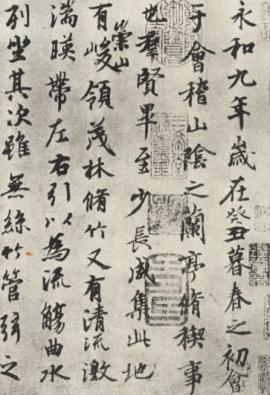 Preface to the poems composed at the Orchid Pavilion by Wang XizhiThis process of assimilation was in no way limited to the Turks adopting Chinese ways though. The Chinese also incorporated some elements of Turkish culture such as certain foods and cooking methods, Turkish vocabulary and so on into their own culture.
Preface to the poems composed at the Orchid Pavilion by Wang XizhiThis process of assimilation was in no way limited to the Turks adopting Chinese ways though. The Chinese also incorporated some elements of Turkish culture such as certain foods and cooking methods, Turkish vocabulary and so on into their own culture.
The Turks that controlled the north of China never ventured as far south as the Yangtze River, being content with controlling the northern areas. The southern areas (known as the Southern Dynasties) still remained distinctly Chinese and absorbed waves of (mostly affluent) refugees from the Turkic - controlled Northern areas. These newcomers from the north, though ethnically Chinese, still distinguished themselves culturally from most of their new southern neighbours.
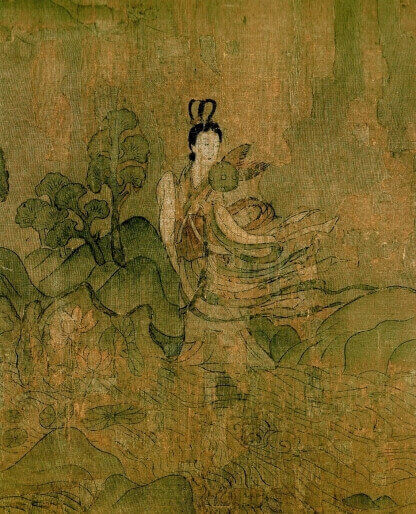 part of the "Ode of the River Goddess" painting by Gu Kaizhi, on display at the National Palace Museum in TaipeiThat realization among the cultured southern elite triggered a period of introspection, where "Chineseness" was newly defined. The educated elite began to kind of compete among themselves to show how sophisticated and how pure Chinese they were. Chinese calligraphy reached new heights of popularity among the educated class during this time.
part of the "Ode of the River Goddess" painting by Gu Kaizhi, on display at the National Palace Museum in TaipeiThat realization among the cultured southern elite triggered a period of introspection, where "Chineseness" was newly defined. The educated elite began to kind of compete among themselves to show how sophisticated and how pure Chinese they were. Chinese calligraphy reached new heights of popularity among the educated class during this time.
Whereas Chinese writing had been purely functional and standardized (due to the efforts of the former Emperor Qin Shi Huang) until then, it now gained an aesthetic quality mixed with a quality of moral righteousness. Good writing became a gentlemanly quality. The writing of poetry and prose proliferated during the Southern dynasties with increasingly elaborate styles of composition. The sophisticated prose written during this time in the South was often very flowery and contained quotations from and veiled references to earlier classic texts that only the culturally "pure Chinese" elite of the South was meant and able to understand.
A group of educated gentlemen organized the now famous "Orchid Pavilion Gathering" along a natural spring (near the city of Shaoxing, Zhejiang province) where they drank wine (a lot of it!) and watched the moon rise while writing poetry. Wang Xizhi, a poet and author who was a participant at this gathering, later wrote the preface for this collection of poetry. The therein described lifestyle came to represent the ideal life of an educated gentleman and Wang Xizhi's aesthetic penmanship came to represent the perfect style of gentlemanly calligraphy.
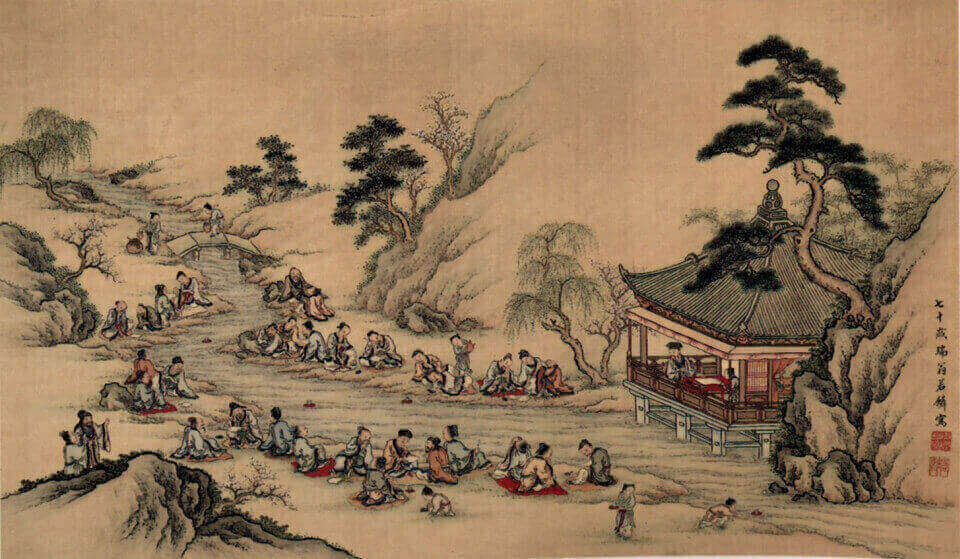 Japanese scroll painting of the Orchid Pavilion Gathering by Yamamoto Jakurin
Japanese scroll painting of the Orchid Pavilion Gathering by Yamamoto Jakurin
Orchid Pavilion (Lanting)
The Orchid Pavilion Garden is located in the southwestern suburbs of Shaoxing (Zhejiang province). Chinese people refer to the place as Lanting, Lanting Pavilion or Lan Pavilion. This tranquil place in the middle of a natural park resembles the southern Chinese gardens of Suzhou or Yangzhou. Its claim to fame reaches far back in Chinese history to AD 353 when the famous Orchid Pavilion Gathering of 42 literati gentlemen took place there.
Click here to learn more!Opening Hours
7.30am - 5pm
Entrance Ticket Prices
40 yuan
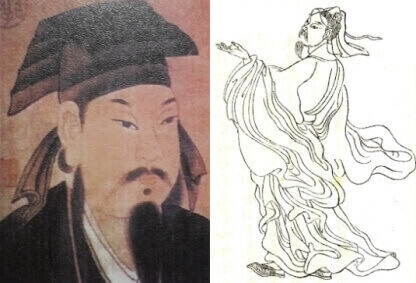 Left: painting of the calligrapher Wang Xizhi Right: the painter Gu KaizhiChinese paintings also made the leap from practical craft (at tombs or as decoration of palaces) to artistry during the Southern dynasties. Just like Wang Xizhi came to be the role model for the perfect style of calligraphy, the artistic paintings of a gentleman named Gu Kaizhi came to represent the highest quality of Chinese paintings.
Left: painting of the calligrapher Wang Xizhi Right: the painter Gu KaizhiChinese paintings also made the leap from practical craft (at tombs or as decoration of palaces) to artistry during the Southern dynasties. Just like Wang Xizhi came to be the role model for the perfect style of calligraphy, the artistic paintings of a gentleman named Gu Kaizhi came to represent the highest quality of Chinese paintings.
By the latter part of the 6th century, the culture in the northern and southern dynasties had approximated mostly through the process of assimilation that the Turkic people underwent in the North.
As far as the religious development in the Southern dynasties is concerned, distinctly Chinese schools of Buddhism such as the Tiantai school and the Chan school (nowadays known in the West as the Zen school of Buddhism) emerged during this period.
But even in the southern areas, people had begun to get used to the presence of Buddhism and to their blended sino-turkic neighbours in the North. The upper classes of society still had a vision of a unified China.
Chinese History Digest's summary of China's history continues in the next section with the reunification of the country during the Sui dynasty.
